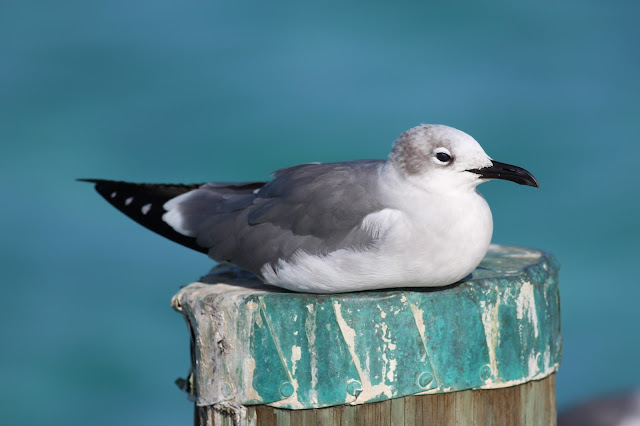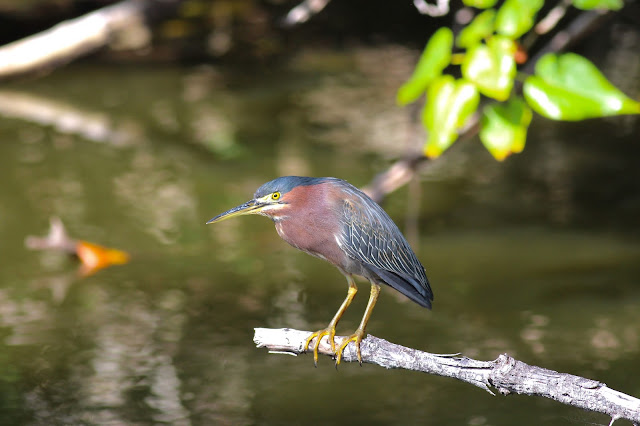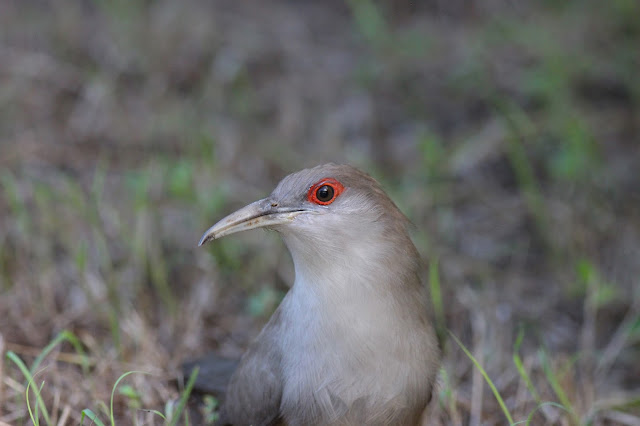This first set were taken during my Xmas vacation in 2015.
Black-faced Grassquits are fairly common although quite shy. This bird thought he was safe deep in the bush but my lens found him and almost crushed him.
Bahama Woodstars are the only hummingbird on Eleuthera but that's fine with me as they are a good one and also fairly tolerant of my crusher.
The Bahama Woodstar has recently been split with Inagua Woodstar being the new split. However, as far as I know there is no Inaguan birds on Eleuthera. The difference is very subtle with length of tail feathers and vocalizations.
Sorry, I just can't seem to whittle down the pics since they are of good quality I am posting them all.
On my first full day in Eleuthera, I headed to a spot where I had Kirkland's Warbler last year. It only took about 2 minutes to find another. Kirtland's Warbler winters in the Bahamas and Eleuthera is probably the best island to see them.
I believe this is a male. It is a bit counterintuitive, you would think the males have more streaking, but I believe it is the other way around. However the real field mark is how brown the back is. The females and immatures have a more brown versus gray back.
This individual was hanging out in a Gumbo Limbo, but they really love White Lantana.
And here is the female in a different spot a mile down the road. Note the brown tones on back.
I am not sure if I can improve on those pics...
Here is a pic I can improve on.... American Oystercatcher.
And another fuzzy pic... but I kept this because it was the only Yellow-bellied Sapsucker I have seen at Calypso.
Thick-billed Vireos are perhaps the most abundant bird on Eleuthera and certainly the most vocal.
Apparently Bahama Woodstars breed year round. I found this youngster begging from mom.
Here she is contemplating whether she wants to part with her breakfast.
Wow! That bills runs pretty deep.
Happy Juvenile with hopefully no internal bleeding.
Its good to be in a place where Common Ground Doves are actually common.
My Dad's Rock Garden is a thing of beauty. An organized chaos of blooms.
White-cheeked Pintail - The ponds were full this year which was bad for the shorebirds, but good for the ducks.
It did not take long for me to find an active Bahama Woodstar nest. This beauty was putting some finishing touches on the nest with lichen.
This nearby male could be the dad, but these hummingbird dads are deadbeats as far as I can tell. Their only job is to provide the genetic package then they are back to being loners.
The man with a vision that is Calypso.
This was the first Yellow-throated Vireo I found.
I found many waterthrushes this year but I think they were all Northern Waterthrushes.
The best fieldmark is the streaking on the throat.
Palm Warblers are very common.
Smooth-billed Anis are more often heard than seen. They sound like the creaking of old trees in the wind.
This Belted Kingfisher took this spot every day I was there, but he never came closer. Typical of this species.
Prairie Warbler
Ovenbird
Bahama Mockingbirds are way more shy than their cousins. However they will come in to playback.
Red-legged Thrushes are usually hard to photograph because they hang out in the understory of the more established woods.
Tarpum Bay is usually loaded with gulls. This time I had some nice Lesser Black-backed Gulls and one mystery bird which I think is a 1st cycle Lesser Black-backed Gull. The bird in the middle is a classic LBBG whereas the bird on the right had much lighter colored legs.
I tried looking at the field guides for other dark backed gulls but he did not seem to fit with any.
Ring-billed Gulls
Royal Tern
Lesser Black-backed Gull
Lesser Black-backed Gull - 1st cycle?
Royal Tern
Laughing Gull
Green Heron
Clapper Rail swimming
Bananaquit
Palm Warbler
American Kestrel
Although the Kirtland's Warbler is the most iconic bird of Eleuthera, the Great Lizard Cuckoo has to be my favorite. They have absolutely no fear of humans and will tolerate me following them around for hours.
The biggest problem is shooting them with a 400mm lens since they are so big and allow you to get so close.
This one bird ate 3 lizards, a huge spider and a couple moths while I watched him.
Least Grebe
Greater Antillean Bullfinch
Common Ground Dove
I saw a couple Western Spindalis from afar but on the last full day in Eleuthera I finally had one cooperative individual near Winding Bay.
This Black-and-White Warbler was also in the small flock.
A true Bird of Paradise
Gray Catbird
My last decent picture for the trip was of this White-crowned Pigeon. I had spent hours trying to hunt one down in the bush but they would always fly off when I got close. Then of course I found this one in the town and it was relatively tame.









































































































superb photos! we (+ your Mom) enjoyed them together.
ReplyDelete